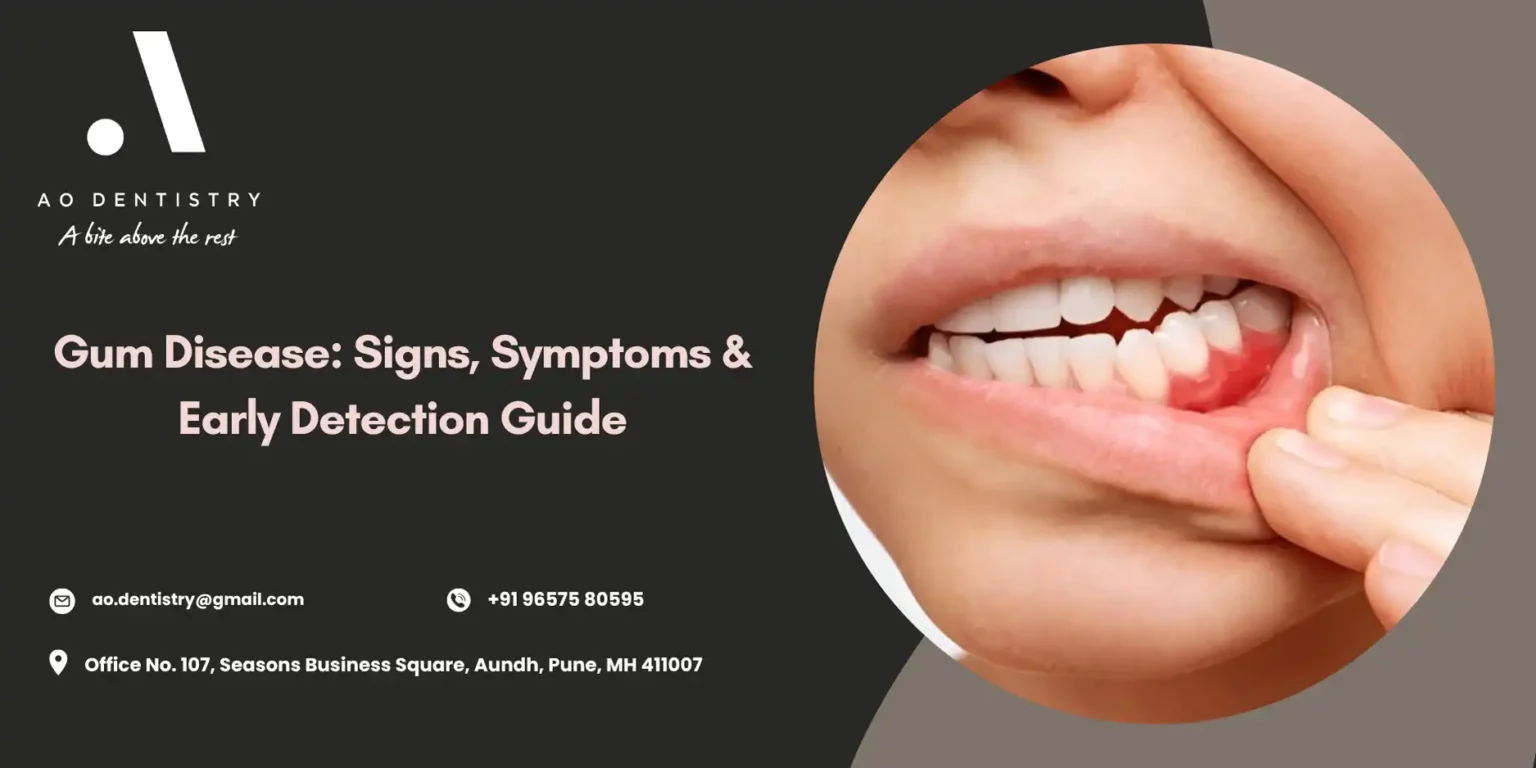Gums can be complex, and people take care of their teeth, but always ignore gums until they start facing problems. And then suddenly they start searching on the internet for gum disease symptoms, or gum infection symptoms , or what is gum disease.
Before looking at all these things, let’s first clear one thing gum disease does not show up overnight. It sneaks in when you are not noticing. Catching the early signs of gum disease is crucial and makes the recovery journey easy.
In this article, we will look at –
Gum disease symptoms,
Gum infection symptoms,
What is gum disease, and
Gum disease signs and symptoms.
Are you confused between aligners and braces? Click here to know about aligners vs braces.
How to Use Mouthwash? Learn more about it in this blog.
What Is Gum Disease (Periodontal Disease)?
Periodontal disease is a medical name for gum disease. Gum disease is an infection that starts small but can grow much bigger if not treated for a long period. It begins with bacteria from plaque buildup that start irritating the gums, causing inflammation and bleeding.
This gum disease can progress into different stages
- Gingivitis – a reversible gum inflammation
- Periodontitis – If gingivitis is left untreated, then it transforms into periodontitis, where the infection spreads under the gumline and attacks the tooth structure.
Understanding what is gum disease and the different stages helps in treating the disease before it damages the teeth structure completely.
Want to know what are the different types of crown? Read here
How to Stop Tooth Decay from Spreading? Read here
Causes of Gum Disease
Before answering all your queries like “gum disease symptoms” or “gum infection symptoms” or ” what are the symptoms of gum disease”, let’s first understand the causes of gum disease.
Here are a few causes of gum disease –
- Skipping proper oral care – When plaque builds up faster when you don’t follow the proper oral hygiene
- Tobacco in all forms – Cigarettes, chewing tobacco, whatever – it’s all terrible for the gums
- Hormonal imbalance – Pregnancy, monthly cycles, and menopause all make gums more sensitive
- Certain prescription medicines – Some medications dry out your mouth, leaving your gums exposed
- Genetics – Sometimes families just pass down gum disease genes
- Health issues like diabetes – These conditions make it harder for your body to fight infections and recover
- Getting older – Risk naturally increases as you age
- Poor diet – Gums need proper nutrition to stay healthy and strong
- Grinding or clenching teeth – Puts extra pressure on everything supporting your teeth
Here is what all you can eat after tooth extraction.
Read more about what causes yellow teeth here
Common Symptoms of Gum Disease
So what should you be watching for? Gum disease symptoms show up overtime, which makes them easier to treat.
Bleeding gums are one of the most easily recognizable gum disease symptoms. Many people think bleeding while brushing is normal and not any sign of gum disease but healthy gums do not bleed with brushing. When the gums are inflamed, they can tear easily
Red, swollen, or tender gums are another clear gum disease symptoms. Healthy gums look pink and feel firm. Red, puffy, and tender gums are a way for the body to respond to bacterial infection
Persistent bad breath or bad taste is usually a result of bacteria producing toxins in infected gum crevices. Brushing and flossing may help with this for a temporary period, but it returns when gum disease is the cause
Receding gums are one of the gum disease signs and symptoms. In this, the teeth appear long as the gum line starts pulling away from the tooth structure. These receding gums expose the sensitive roots and more crevices for bacteria to build up easily
Pain while eating can develop as the gum infection affects the structure that supports your teeth, making normal eating more difficult. Making it easily recognizable gum infection symptoms or gum disease symptoms.
What Are the Symptoms of Gum Disease in Different Stages?
Figuring out gum disease signs and symptoms gets easier when you know how the situation worsens. Each stage has its symptoms and level of seriousness
Early-Stage Gum Disease (Gingivitis)
Gingivitis is kind of the best scenario, as in this stage, the gums can recover to normal. In this, your gums look red, swollen, and bleed whenever you brush or floss. The good news is that no permanent damage has happened yet. With good oral hygiene and professional help in cleaning the hardened plaque buildup, gingivitis can be fully eliminated
Moderate Gum Disease
When the gingivitis or early-stage gum disease is ignored, gum infection symptoms or gum disease symptoms become more serious and progress to the next level. The infection starts affecting the whole structure that holds the teeth and supports them, while creating deep pockets between the gums and teeth where bacteria can live and build plaque
In this stage, you will experience consistent bad breath, and gums start pulling away from your teeth
Advanced Gum Disease (Periodontitis)
This is the most severe stage of gum disease nobody wants to reach. This stage is called periodontitis. In medical terms, it means significant damage has already been done. What are the symptoms of gum disease at this stage? There will be deep crevices between teeth and gum, a severe level of recession, difficulty while eating, teeth might feel loose and even the possibility of losing teeth.
Read to know if RCT is Painful
Click for home remedies for swollen gums
How to Prevent Gum Disease
Prevention is always the best strategy, which is easier, less costly, and less painful. The basic way to prevent gum disease or gum infection symptoms is to remove the plaque buildup before it turns into gum disease symptoms.
- While brushing, use a fluoride toothpaste and focus on parts where gums meet the tooth, as that’s where the plaque starts building up.
- Visit the dentist every 6 months to remove the tartar that can’t be cleaned at home
- Eat clean food with vitamins and minerals, and stay away from tobacco.
When to See a Dentist
Don’t wait for the gum disease symptoms or gum infection symptoms to become more severe
Visit the dentist if you are experiencing the following gum disease signs and symptoms –
- Consistent bleeding gums
- Bad breath even after brushing
- Teeth feeling loose
- Difficulty in eating
Even if you are not noticing any of the gum infection symptoms, it is suggested to visit the dentist every 6 months. It can not only help in cleaning the buildup of tartar but also detect any early gum disease signs and symptoms.
Here’s how to Stop Grinding Teeth in Sleep Naturally
FAQs
Q1. Can you self-treat gum disease?
Ans. Yes, a gingivitis level gum disease can be self-treated with proper oral hygiene. But severe gum disease needs proper dental intervention.
Q2. Can you live a full life with gum disease?
Ans. Yes, detecting the early gum disease signs and symptoms and proper care can help you live a normal and healthy life.
Q3. What are the warning signs of gum disease?
Ans. The warning signs of gum disease include bleeding gums, bad breath, swollen gums, and loose teeth.
Q4. Can gum disease be cured?
Ans. Yes, gingivitis can be completely recovered from, and advanced-level disease can be stabilized with the help of the dentist.
Q5. What is the last stage of gum disease?
Ans. Advanced periodontitis is the last stage of gum disease in which you may experience bone loss, loose teeth, and even tooth loss.
Q6. Does salt water help gum disease?
Ans. Yes, saltwater rinse can bring temporary relief but can’t cure the disease.
If you are experiencing any of the gum disease symptoms, don’t wait for them to become severe. Book your appointment today with AO Dentistry at +91 96575 80595.


